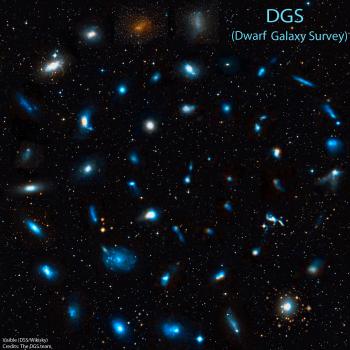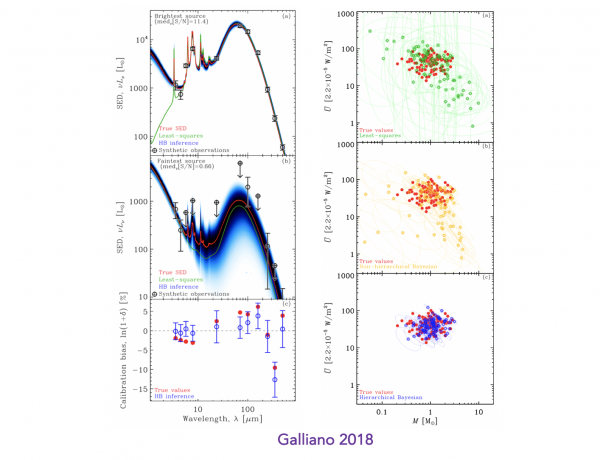"The ISM in Low Metallicity Environments: Bridging the Gap Between Local Universe and Primordial Galaxies"
The Herschel Dwarf Galaxy Survey is a Guaranteed Time Key Program led by Suzanne Madden.
Abstract:
While much of what we have gleaned of the details of dust and gas properties and the processes of dust recycling and heating and cooling in galaxies has been limited to Galactic studies, with Herschel we will be able to explore these issues in low metallicity dwarf galaxies which are known by now to exhibit dust and gas properties different from more metal-rich galaxies. Because these objects are relatively nearby, it is possible to relate the observed variations in the SEDs to the actual physical phenomena occuring within the ISM of the galaxy, allowing the construction of a rich interpretative framework for unresolved, more distant galaxies in the early universe. Using the SPIRE and PACS instruments on Herschel, we propose to map the dust and gas in a 50 dwarf galaxies, sampling a broad metallicity range of 1/50 to 1/2 solar. These data, in conjunction with other ancillary data, will be used to construct the emission spectrum of the dust plus that of the gas in the most important cooling lines. The combination of these instruments onboard Herschel will provide the first opportunity to study the dust and gas in extremely low metallicity environments that have not yet experienced repeated recycling through the ISM. The interpretation of this data will open the door to comprehending primordial ISM conditions and star formation in the young universe.
Sample
The Herschel Dwarf Galaxy Survey has observed 50 galaxies, including regions of the Magellanic Clouds, Local Group galaxies, and galaxies out to a distance of 200 Mpc. They were chosen to cover a broad range of metallicities, from 1/50 to 1/2 solar. The sample was selected from surveys of metal-poor Blue Compact Dwarf galaxies and of emission line galaxies identified in the Hamburg/SAO Survey and the First and Second Byurakan Surveys.
|
|
|||||||||
| # | Object Name | RA (J2000) | Dec (J2000) | Redshift | 12 + log(O/H) | D25 (arcmin2) | MB (mag) | log(LTIR/L?) | log(M?/M?) |
| Extended Objects | |||||||||
| 1 | IC 10 | 00h20m17.3s | +59d18m14s | -0.0012 | 8.17 | 6.8 × 5.9 | -12.43 | 8.22 | 8.60 |
| 2 | NGC 1140 | 02h54m33.6s | -10d01m40s | 0.0050 | 8.38 | 1.7 × 0.9 | -18.55 | 9.57 | 9.65 |
| 3 | NGC 1569 | 04h30m46.1s | +64d50m53s | -0.0003 | 8.02 | 3.6 × 1.8 | -15.75 | 9.10 | 8.93 |
| 4 | NGC 1705 | 04h54m13.5s | -53d21m40s | 0.0021 | 8.27 | 1.9 × 1.4 | -15.73 | 7.84 | 8.34 |
| 5 | NGC 2366 | 07h28m54.7s | +69d12m57s | 0.0003 | 7.70 | 8.1 × 3.3 | -16.18 | 8.14 | 8.29 |
| 6 | NGC 4214 | 12h15m39.2s | +36d19m37s | 0.0010 | 8.26 | 8.5 × 6.6 | -17.11 | 8.73 | 8.92 |
| 7 | NGC 4449 | 12h28m11.1s | +44d05m37s | 0.0007 | 8.20 | 6.2 × 4.4 | -17.94 | 9.34 | 9.43 |
| 8 | NGC 4861 | 12h59m02.3s | +34d51m34s | 0.0028 | 7.89 | 4.0 × 1.5 | -16.84 | 8.54 | 8.49 |
| 9 | NGC 5253 | 13h39m56.0s | -31d38m24s | 0.0014 | 8.25 | 5.0 × 1.9 | -16.87 | 9.21 | 8.77 |
| 10 | NGC 625 | 01h35m04.6s | -41d26m10s | 0.0013 | 8.22 | 5.8 × 1.9 | -16.20 | 8.46 | 8.73 |
| 11 | NGC 6822 | 19h44m56.6s | -14d47m21s | -0.0002 | 7.96 | 15.5 × 13.5 | -13.19 | 7.56 | 8.19 |
| Compact Objects | |||||||||
| 12 | Haro 11 | 0h36m52.5s | -33d33m19s | 0.0206 | 8.36 | 0.5 × 0.4 | -20.55 | 11.30 | 10.24 |
| 13 | Haro 2 | 10h32m31.9s | +54d24m04s | 0.0048 | 8.23 | 1.2 × 0.8 | -18.28 | 9.80 | 9.56 |
| 14 | Haro 3 | 10h45m22.4s | +55d57m37s | 0.0031 | 8.28 | 1.2 × 0.8 | -18.29 | 9.73 | 9.49 |
| 15 | He 2-10 | 8h36m15.2s | -26d24m34s | 0.0029 | 8.43 | 1.9 × 1.4 | -17.25 | 9.74 | 9.50 |
| 16 | HS 0017+1055 | 0h20m21.4s | +11d12mm21s | 0.0188 | 7.63 | - | -16.23 | 8.99 | 7.84 |
| 17 | HS 0052+2536 | 0h54m56.4s | +25d53m08s | 0.0454 | 8.07 | - | -19.56 | 10.23 | 10.31 |
| 18 | HS 0822+3542 | 8h25m55.5s | +35d32m32s | 0.0024 | 7.32 | 0.27 × 0.11 | -12.40 | 7.02 | 6.48 |
| 19 | HS 1222+3741 | 12h24m36.7s | +37d24m37s | 0.0409 | 7.79 | 0.12 × 0.11 | -17.90 | 9.38 | 9.37 |
| 20 | HS 1236+3937 | 12h39m20.1s | +39d21m05s | 0.0184 | 7.72 | 0.34 × 0.09 | -16.00 | - | 9.17 |
| 21 | HS 1304+3529 | 13h06m24.2s | +35d13m42s | 0.0165 | 7.93 | 0.28 × 0.21 | -17.73 | 9.24 | 8.58 |
| 22 | HS 1319+3224 | 13h21m19.9s | +32d08m23s | 0.0182 | 7.81 | 0.14 × 0.11 | -15.68 | 8.37 | 8.05 |
| 23 | HS 1330+3651 | 13h33m08.3s | +36d36m33s | 0.0167 | 7.98 | 0.29 × 0.19 | -17.81 | 9.14 | 8.95 |
| 24 | HS 1442+4250 | 14h44m12.8s | +42d37m44s | 0.0021 | 7.60 | 1.13 × 0.26 | -15.15 | - | - |
| 25 | HS 2352+2733 | 23h54m56.7s | +27d49m59s | 0.0276 | 8.40 | - | -17.05 | - | 8.11 |
| 26 | I Zw 18 | 9h34m02.0s | +55d14m28s | 0.0025 | 7.14 | 0.3 × 0.3 | -15.22 | 7.52 | 7.34 |
| 27 | II Zw 40 | 5h55m42.6s | +3d23m32s | 0.0026 | 8.23 | 0.56 × 0.22 | -14.93 | 9.46 | - |
| 28 | Mrk 1089 | 5h01m37.8s | -4d15m28s | 0.0134 | 8.10 | 0.61 × 0.23 | -20.46 | 10.55 | 10.28 |
| 29 | Mrk 1450 | 11h38m35.6s | +57d52m27s | 0.0032 | 7.84 | 0.40 × 0.31 | -13.86 | 8.48 | 8.09 |
| 30 | Mrk 153 | 10h49m05.0s | +52d20m08s | 0.0080 | 7.86 | 0.54 × 0.30 | -18.03 | 9.02 | 9.06 |
| 31 | Mrk 209 | 12h26m16.0s | +48d29m37s | 0.0009 | 7.74 | 0.8 × 0.6 | -13.67 | 7.45 | 7.46 |
| 32 | Mrk 930 | 23h31m58.3s | +28h56m50s | 0.0183 | 8.03 | 0.43 × 0.43 | -19.50 | 10.28 | 9.44 |
| 33 | Pox 186 | 13h25m48.7s | -11d36m38s | 0.0039 | 7.70 | - | -12.17 | 7.76 | 7.08 |
| 34 | SBS 0335-052 | 3h37m44.1s | -5d02m40s | 0.0135 | 7.25 | 0.23 × 0.20 | -16.02 | 9.25 | 8.03 |
| 35 | SBS 1159+545 | 12h02m02.4s | +54d15m50s | 0.0118 | 7.44 | 0.20 × 0.10 | -15.08 | 8.30 | 7.85 |
| 36 | SBS 1211+540 | 12h14m02.5s | +53d45m17s | 0.0030 | 7.58 | 0.26 × 0.17 | -13.43 | 7.46 | 7.60 |
| 37 | SBS 1249+493 | 12h51m52.5s | +49d03m27s | 0.0243 | 7.68 | 0.10 × 0.10 | - | 8.97 | 8.42 |
| 38 | SBS 1415+437 | 14h17m01.4s | +43d30m05s | 0.0020 | 7.55 | 0.75 × 0.15 | -14.99 | 7.82 | - |
| 39 | SBS 1533+574 | 15h34m13.8s | +57d17m06s | 0.0110 | 8.05 | 0.67 × 0.67 | -16.69 | 9.28 | 7.30 |
| 40 | Tol 0618-402 | 6h20m02.6s | -40d18m09s | 0.0350 | 8.09 | 0.4 × 0.3 | - | - | 10.43 |
| 41 | Tol 1214-277 | 12h17m17.1s | -28d02m33s | 0.0260 | 7.52 | 0.08 × 0.05 | |||
| 42 | UGC 4483 | 8h37m03.0s | +69d46m31s | 0.0005 | 7.46 | 1.4 × 0.7 | -12.53 | 6.50 | 6.90 |
| 43 | UGCA 20 | 1h43m14.7s | +19d58m32s | 0.0017 | 7.50 | 3.1 × 0.8 | -14.43 | - | 7.54 |
| 44 | UM 133 | 1h44m41.3s | +4d53m26s | 0.0054 | 7.82 | 1.0 × 1.0 | -15.72 | 7.86 | 7.81 |
| 45 | UM 311 | 1h15m34.4s | -0d51m46s | 0.0056 | 8.37 | 0.11 × 0.10 | -19.22 | 9.74 | - |
| 46 | UM 448 | 11h42m12.4s | +0d20m03s | 0.0186 | 8.32 | 0.4 × 0.4 | -20.02 | 10.95 | 10.62 |
| 47 | UM 461 | 11h51m33.4s | -2d22m22s | 0.0035 | 7.73 | 0.30 × 0.22 | -13.73 | 7.85 | 7.66 |
| 48 | VII Zw 403 | 11h27m59.9s | +78d59m39s | -0.0003 | 7.66 | 1.4 × 0.8 | -13.77 | 7.30 | 7.20 |
| LMC and SMC regions | |||||||||
| 001 | LMC - 30 Dor | 05h38m42.3s | -69d06m03s | 0.0009 | 8.5 | 645 × 550 | -17.58 | 9.15 | 9.30 |
| 002 | LMC - N11 A | 04h57m16.2s | -66d23m20s | 0.0009 | 8.5 | 645 × 550 | -17.58 | 9.15 | 9.30 |
| 003 | LMC - N11 B | 04h56m51.5s | -66d24m25s | 0.0009 | 8.5 | 645 × 550 | -17.58 | 9.15 | 9.30 |
| 004 | LMC - N11 C | 04h57m48.3s | -66d28m32s | 0.0009 | 8.5 | 645 × 550 | -17.58 | 9.15 | 9.30 |
| 005 | LMC - N11 I | 04h55m44.3s | -66d34m28s | 0.0009 | 8.5 | 645 × 550 | -17.58 | 9.15 | 9.30 |
| 006 | LMC - N158 | 05h39m14.0s | -69d30m18s | 0.0009 | 8.5 | 645 × 550 | -17.58 | 9.15 | 9.30 |
| 007 | LMC - N159 | 05h39m52.8s | -69d45m20s | 0.0009 | 8.5 | 645 × 550 | -17.58 | 9.15 | 9.30 |
| 008 | LMC - N160 | 05h39m42.2s | -69d38m51s | 0.0009 | 8.5 | 645 × 550 | -17.58 | 9.15 | 9.30 |
| 009 | SMC - N66 | 00h59m25.4s | -72d10m10s | 0.0005 | 8.0 | 320 × 185 | -16.19 | 8.02 | 8.62 |
|
|
|||||||||
Herschel PACS and SPIRE Observations
Our sample consist of 50 galaxies observed with PACS and SPIRE in photometry and spectroscopy (Madden et al. 2013). The spectroscopy of the extended sources was observed as part of the SHINING program (Sturm et al. 2011). The photometry of the Magellanic Clouds belongs to the HERITAGE program (Meixner et al. 2013). |
Table keys: • = in our program • = in the archive • = no 70 or 100µm |






